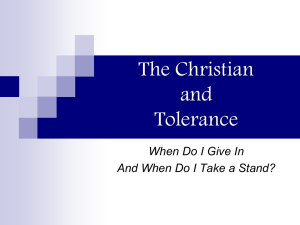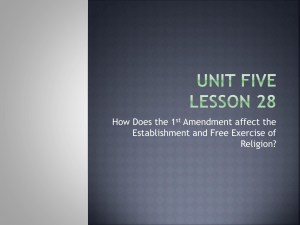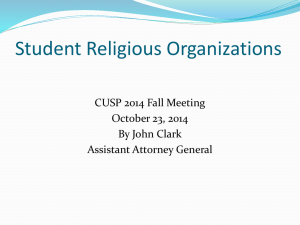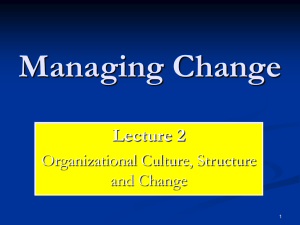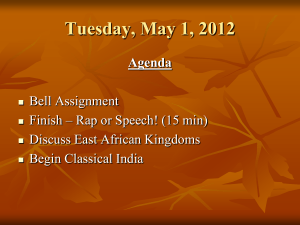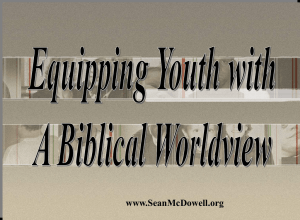Religious Freedom Day Presentation
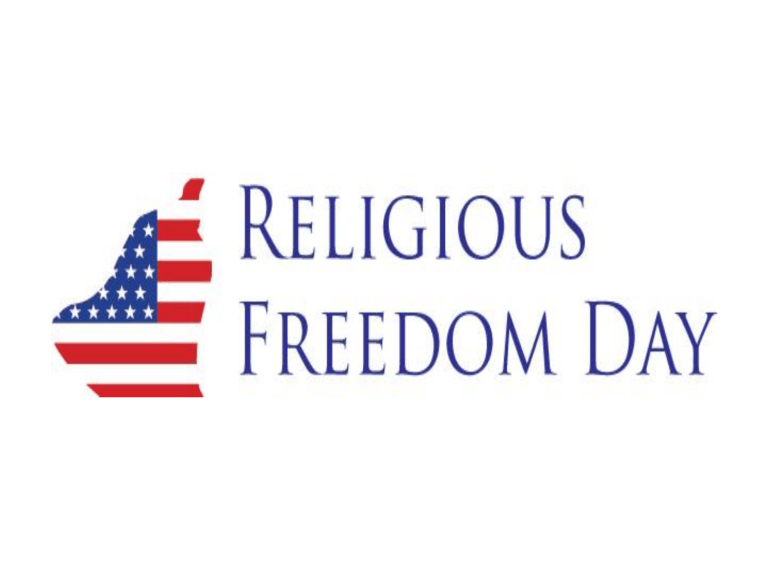
Today’s Talking Points
• What is America’s Religious Freedom Day?
• What is Religious Freedom?
• Working Towards Greater Tolerance
Who am I?
• Protestant Christian
• American
• Graduated magna cum laude from George Mason
University with a dual-major Bachelor of Arts in
History and Religious Studies
• I am not a policy or government expert, I am not an established religious leader or priest, nor am I an expert in Montenegrin society
• Have lived and traveled abroad extensively
Theology vs. Religious Studies
• Theology is the study of religious truths within the parameters of a religion
• Religious studies is the study of religion as a liberal art, “the academic field of multidisciplinary, secular study of religious beliefs, behaviors, and institutions. It describes, compares, interprets, and explains religion, emphasizing systematic, historically based, and cross-cultural perspectives.”
– Study/observation without ‘buy-in’
– I majored in religious studies as a tool to better understand history, the human condition, and the human experience
What is Religion?
• This is a complex question with many possible answers; according to
Judge Adams of the US Third Circuit court:
– A religion deals with issues of ultimate concern; with what makes life worth living; with basic attitudes toward fundamental problems of human existence.
– A religion presents a comprehensive set of ideas--usually as "truth," not just theory.
– A religion generally has surface signs (such as clergy, observed holidays, and ritual) that can be analogized to well-recognized religions.
• Noted anthropologist Clifford Geertz defined religion as:
– “A system of symbols which acts to establish powerful, pervasive, and long-lasting moods and motivations in men by formulating conceptions of a general order of existence and clothing these conceptions with such an aura of factuality that the moods and motivations seem uniquely realistic.”
• Is either definition useful when considering “Religious Freedom?”
Pilgrims, the Forming of America, and Tolerance
• The first European settlers in America were were part of a religious minority who were suffering civil punishment, sometimes culminating in public execution for exercising their religious beliefs
• Instead of rising up in arms to change
England’s religious landscape, they removed themselves from society and reformed their society in order to allow for universal religious freedom
What is Religious Freedom Day?
Every year, the President of the United States declares January 16th to be Religious Freedom
Day, and calls upon Americans to "observe this day through appropriate events and activities in homes, schools, and places of worship." The day is the anniversary of the adoption, in 1786, of the Virginia Statute of Religious Freedom.
Virginia Statute for Religious Freedom
Written in 1777, Enacted into Law in 1786
3 rd President of the United States of America
Here was buried Thomas Jefferson, author of the Declaration of American Independence, of the
Statute of Virginia for Religious Freedom, and father of the University of Virginia.
First Amendment of the US
Constitution
Congress shall make no law respecting an establishment of religion , or prohibiting the free exercise thereof ; or abridging the freedom of speech, or of the press; or the right of the people peaceably to assemble, and to petition the
Government for a redress of grievances.
• Two parts: the Establishment Clause and Free
Exercise Clause
“Compulsion in religion is distinguished peculiarly from compulsion in every other thing. I may grow rich by art I am compelled to follow, I may recover health by medicines I am compelled to take against my own judgment, but I cannot be saved by a worship I disbelieve & abhor.”
“the opinions of men are not the object of civil government, nor under its jurisdiction; that to suffer the civil magistrate to intrude his powers into the field of opinion and to restrain the profession or propagation of principles on supposition of their ill tendency is a dangerous fallacy, which at once destroys all religious liberty”
-Thomas Jefferson
The Establishment Clause
“At an absolute minimum, the Establishment
Clause was intended to prohibit the federal government from declaring and financially supporting a national religion, such as existed in many other countries at the time of the nation's founding. It is far less clear whether the
Establishment Clause was also intended to prevent the federal government from supporting Christianity in general. ”
The Free Expression Clause
• It states that the government shall make no law prohibiting the free exercise of religion.
• Although the text is absolute, the courts place some limits on the exercise of religion. According to the interpretations of the Supreme Court, the freedom to believe is absolute, but the ability to act on those beliefs is not.
• “Congress cannot pass a law for the government of the
Territory which shall prohibit the free exercise of religion…Laws are made for the government of actions, and while they cannot interfere with mere religious beliefs and opinions, they may with practices.” – From
Reynolds vs. United States, 1878
Believing in the Great Green Sky
• As an example…suppose you founded a religion that believes that the sky is green. Your holy book states that the sky is green and admonishes you to help it to be so.
• You can put green stained glass in your house, walk under a translucent green umbrella, etc.
• But you can’t try and replace someone else’s windows or spew green chemicals into the air
• More seriously, if your religion allows polygamy
(for example), you still cannot legally practice it in the US
The American Religious Landscape
Approximate 2012
Values in Millions
2012 : 228 million
2012 : 18.8 million
2012 : 61.35 million
2012 : 6.26 million
2012 US Population: 313 million
An Example of Pluralism
• ~73% of Americans Christian
• A large public university includes: 2 Muslim student groups, 2 Jewish, 1 Coptic Orthodox, 1
Sikh, 1 Mormon, 1 Buddhist, 1 Lutheran, 16 non-denominational Protestant, 2 philosophical, and 1 Catholic student group.
– 74% Christian groups…America’s statistical diversity evidenced in a typical university
What is Religious Freedom?
• ARTICLE 9 of the European Convention on Human
Rights
– Everyone has the right to freedom of thought, conscience and religion; this right includes freedom to change his religion or belief, and freedom, either alone or in community with others and in public or private, to manifest his religion or belief, in worship, teaching, practice and observance.
– Freedom to manifest one's religion or beliefs shall be subject only to such limitations as are prescribed by law and are necessary in a democratic society in the interests of public safety, for the protection of public order, health or morals, or the protection of the rights and freedoms of others.
The Non-Religious and Religious
Freedom
• The beliefs of Atheists, Agnostics, and Skeptics are in many ways similar to a religion, save only for their lack of rite and clergy
• Societal discussions of religious freedom must include these groups of individuals
• These groups of individuals must be held to the same standards as religious persons
• Non-religion can be ‘pushed’ just as religion can, and it is just as intolerable
It Starts With You
• “States are not moral agents, people are, and can impose moral standards on powerful institutions.” – Noam Chomsky
• Religious freedom begins with the premise of religious tolerance
• An intolerant society is incapable of having true religious freedom, even if religious freedoms are written into its laws
• Societal tolerance is the sum of individual tolerances
• Tolerance does not require capitulation of deeplyheld religious beliefs!
Importance of Tolerance
• “If we don't believe in freedom of expression for people we despise, we don't believe in it at all.”
• Religious intolerance is an excuse or motivation for the improper treatment of others
• Religious differences often focused on in the actions, not beliefs, of others
– More true in societies where ethno-religious violence is minimal
• Behaviors often seen in decisions made when raising children
• Religious tolerance, and by extension, religious freedom, are means to achieve an end – lives lived peaceably and without fear
Interfaith Dialogue
• Communication between members of multiple different faith groups
• Its goal is understanding the other and finding common ground; proselytizing is a byproduct, not the objective
• 2 levels:
– First, focus on common ground
• “most of we time we are satisfied with mouthing a few noble, often-repeated sentiments”
– Second, explore differences
• More contentious and difficult, but potentially more rewarding
– If you don't like what someone has to say, have a constructive debate with them!
Who to Talk to
• Friends: may be the most comfortable at first, but challenging discussions can alienate them; their knowledge can be variable
• Scholars/Professors: usually possess a
‘detached’ viewpoint, find one whose specialty matches your interests
• Priests, Pastors, Imams, etc.: usually very knowledgeable about their religious tradition
• Remember your source’s perspective! What is their background, sect, training, etc.
How to Talk to Them
• Friends
– Be clear about what you want
– Don’t casually bring up in social call (or expect proselytization)
– Outline questions/expectations clearly
– Be polite and prepared to listen
– Don’t try to tell them what their beliefs are
• Professionals
– Do homework
– Start/end time
– Outline questions/expectations clearly
– Be polite and prepared to listen
– Don’t try to tell them what their beliefs are
Independent Research
• Above all, consider the source!
• Diversify your sources of information
• Ensure you research a webpage’s source, or a book’s author and not just its content
• Use Wikipedia or webpages without specific authors only as a starting point
Resources
• Notes on Religion (October 1776), published in The Works of
Thomas Jefferson in Twelve Volumes, Federal Edition, Paul
Leicester Ford, ed., New York: G. P. Putnam's Sons, 1904, Vol. 2.
• http://www.religiousfreedomday.com/
• http://www.religiousfreedom.com/
• http://law2.umkc.edu/faculty/projects/ftrials/conlaw/estabinto.ht
m
• http://gmu.collegiatelink.net/organizations
• http://www.pewforum.org/
• http://www.huffingtonpost.com/rabbi-eric-h-yoffie/whyinterfaith-dialogue-d_b_867221.html
• http://www.state.gov/secretary/rm/2012/09/197654.htm
• http://www.law.cornell.edu/wex/free_exercise_clause
• http://www.firstamendmentcenter.org/free-exercise-clause
• http://www.hri.org/docs/ECHR50.html#C.Art9


